#Writer Notes
Explore tagged Tumblr posts
Text
More on pre-electricity lighting.
Interesting to see this one pop up again after nearly two years - courtesy of @dduane, too! :->
*****
After experiencing a couple more storm-related power cuts since my original post, as well as a couple of after-dark garden BBQs, I've come to the conclusion that C.J. Cherryh puts far too much emphasis on "how dark things were pre-electric light".
For one thing eyes adjust, dilating in dim light to gather whatever illumination is available. Okay, if there's none, there's none - but if there's some, human eyes can make use of it, some better or just faster than others. They're the ones with "good night vision".
Think, for instance, of how little you can see of your unlit bedroom just after you've turned off the lights, and how much more of it you can see if you wake up a couple of hours later.
There's also that business of feeling your way around, risking breaking your neck etc. People get used to their surroundings and, after a while, can feel their way around a familiar location even in total darkness with a fair amount of confidence.
Problems arise when Things Aren't Where They Should Be (or when New Things Arrive) and is when most trips, stumbles, hacked shins and stubbed toes happen, but usually - Lego bricks and upturned UK plugs aside - non-light domestic navigation is incident-free.
*****
Here are a couple of pics from one of those BBQs: one candle and a firepit early on, then the candle, firepit and an oil lamp much later, all much more obvious than DD's iPad screen.
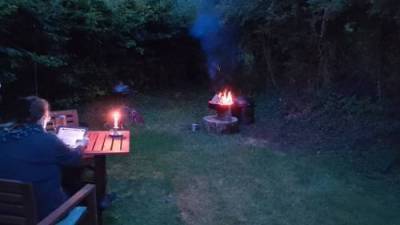
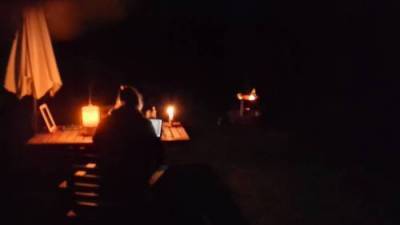
Though I remain surprised at how well my phonecam was handling this low light, my own unassisted eyes were doing far better. For instance, that area between the table and the firepit wasn't such an impenetrable pool of darkness as it appears in the photo.
I see (hah!) no reason why those same Accustomed Eyes would have any more difficulty with candles or oil lamps as interior lighting, even without the mirrors or reflectors in my previous post.
With those, and with white interior walls, things would be even brighter. There's a reason why so many reconstructed period buildings in Folk Museums etc. are (authentically) whitewashed not just outside but inside as well. It was cheap, had disinfectant qualities, and was a reflective surface. Win, win and win.
*****
All right, there were no switches to turn on a light. But there was no need for what C.J. describes as stumbling about to reach the fire, because there were tinderboxes and, for many centuries before them, flint and steel. Since "firesteels" have been heraldic charges since the 1100s, the actual tool must have been in use for even longer.
Tinderboxes were fire-starter sets with flint, steel and "tinder" all packed into (surprise!) a box. The tinder was easily lit ignition material, often "charcloth", fabric baked in an airtight jar or tin which would now start to glow just from a spark.
They're mentioned in both "The Hobbit" and "The Lord of the Rings". Oddly enough, "Hobbit" mentions matches in a couple of places, but I suspect that's a carry-over from when it was just a children's story, not part of the main Legendarium.
Tinderboxes could be simple, just a basic flint-and-steel kit with some tinder for the sparks to fall on...
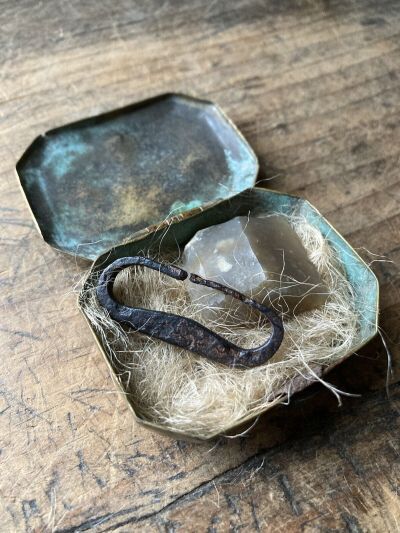
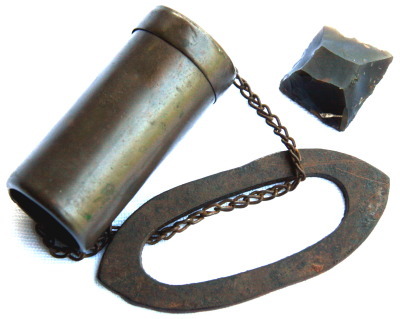
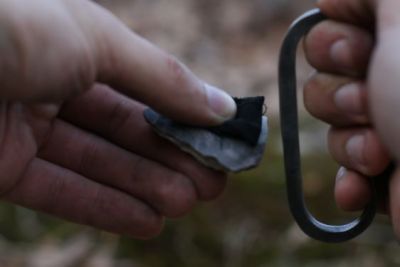
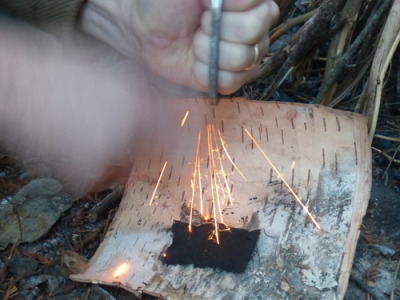
...or elaborate like this one, with a fancy striker, charcloth, kindling material and even wooden "spills" (long splinters) to transfer flame to a candle or the kindling...
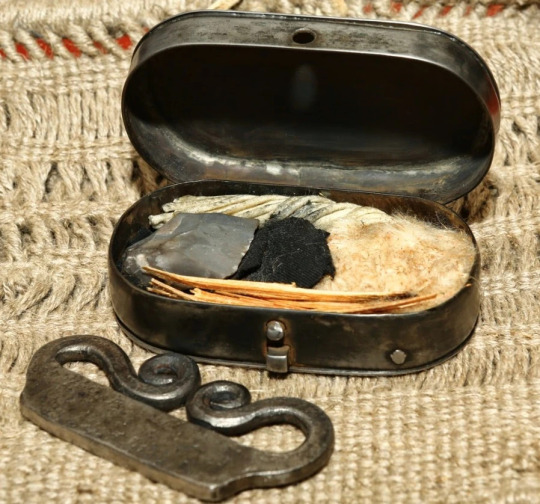
This tinderbox even doubles as a candlestick, complete with a snuffer which would have been inside along with everything else.
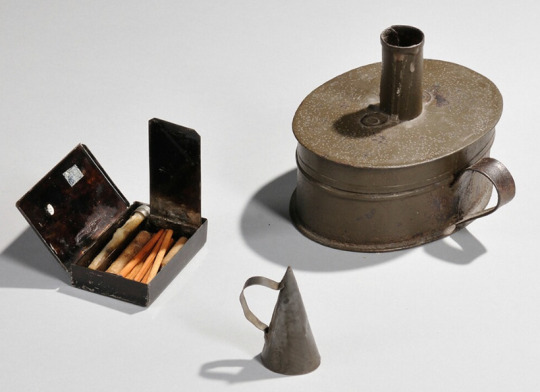
Here's a close-up of the striker box with its inner and outer lids open:
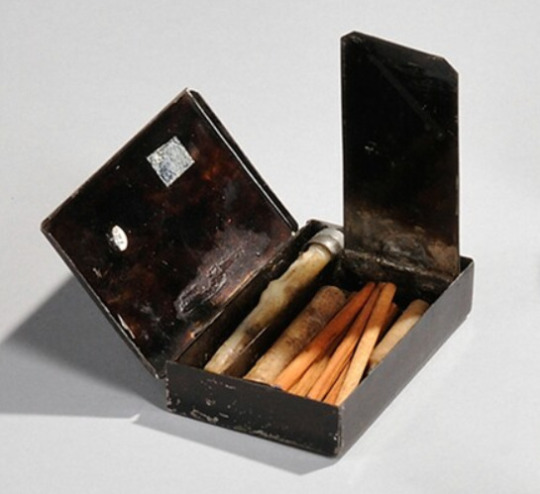
What looks like a short pencil with an eraser is actually the striker. A bit of tinder or charcloth would have been pulled through that small hole in the outer lid, which was then closed.
There was a rough steel surface on the lid, and the striker was scraped along it, like so:

This was done for a TV show or film, so the tinder was probably made more flammable with, possibly, lighter fuel. That would be thoroughly appropriate, since a Zippo or similar lighter works on exactly the same principle.
A real-life version of any tinderbox would usually just produce glowing embers needing blown on to make a flame, which is shown sometimes in movies - especially as a will-it-light-or-won't-it? tension build - but is usually a bit slow and non-visual for screen work.
*****
There were even flintlock tinderboxes which worked with the same mechanism as those on firearms. Here's a pocket version:
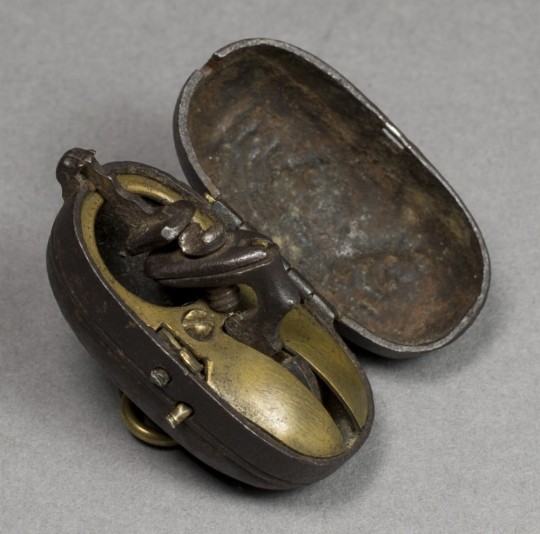
Here are a couple of bedside versions, once again complete with a candlestick:
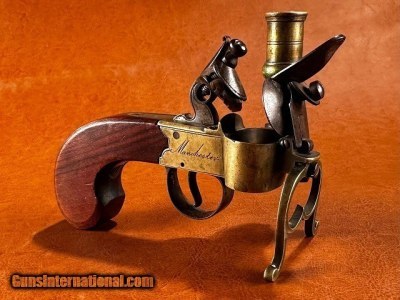
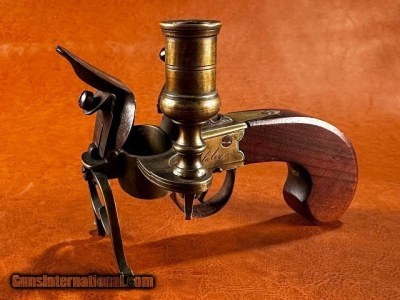
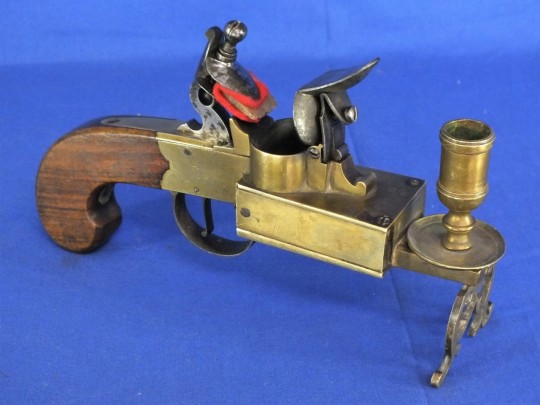
And here are three (for home defence?) with a spotlight candle lantern on one side and a double-trigger pistol on the other.

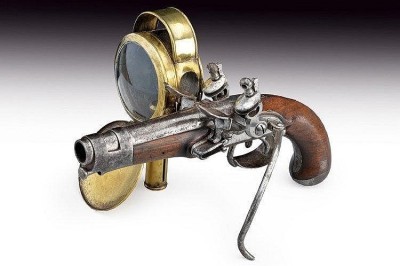
Pull one trigger to light the candle, pull the other trigger to fire the gun.
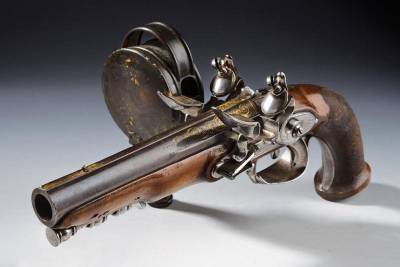
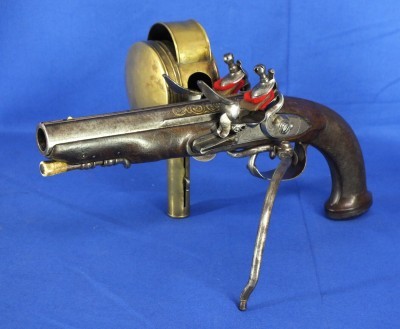
What could possibly go wrong? :-P
*****
Those pistol lanterns, magnified by lenses, weren't just to let their owner see what they were shooting at: they would also have dazzled whatever miscreant was sneaking around in the dark, irises dilated to make best use of available glimmer.
Swordsmen both good and bad knew this trick too, and various fight manuals taught how to manage a thumb-shuttered lamp encountered suddenly in a dark alley.
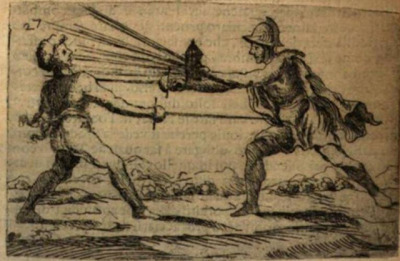
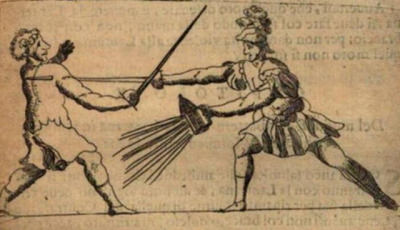
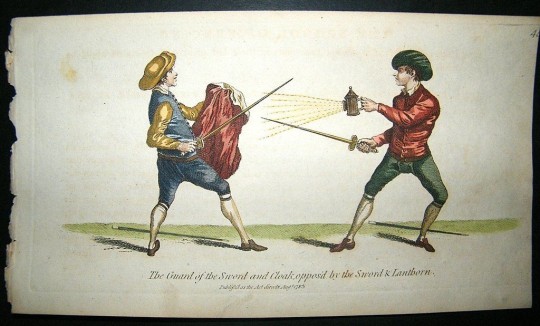
There's a sword-and-lantern combat in the 1973 "Three Musketeers" between Michael York (D'Artagnan) and Christopher Lee (Rochefort), which was a great idea.
Unfortunately it failed in execution because the "Hollywood Darkness" which let viewers see the action, wasn't dark enough to emphasise the hazards / advantages of snapping the lamps open and shut.
This TV screencap (can't get a better one, the DVD won't run in a computer drive) shows what I mean.
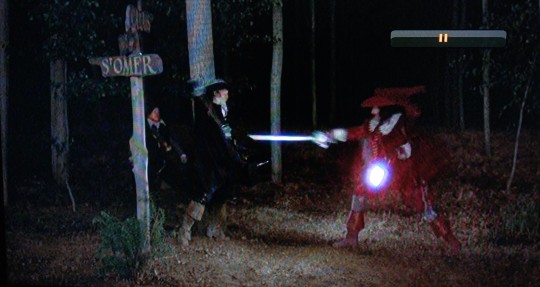
In fact, like the photos of the BBQ, this image - and entire fight - looks even brighter through "real eyes" than with the phonecam. Just as there can be too much dark in a night scene, there can also be too much light.
*****
One last thing I found when assembling pics for the post were Folding Candle-lanterns.
They were used from about the mid-1700s to the later 20th century (Swiss Army ca. 1978) as travel accessories and emergency equipment, and IMO - I've Made A Note - they'd fit right into a fantasy world whose tech level was able to make them.
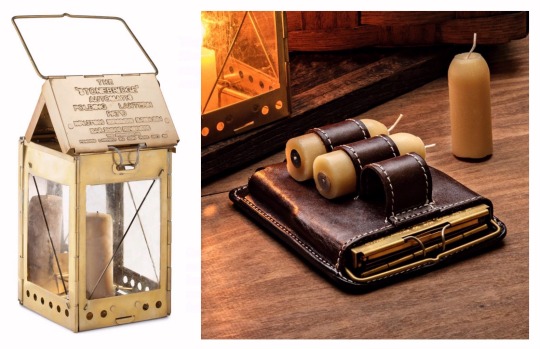
The first and last are reproductions: this one is real, from about 1830.
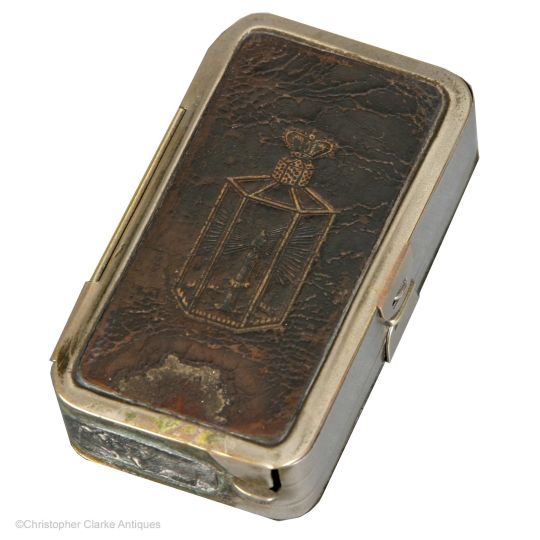
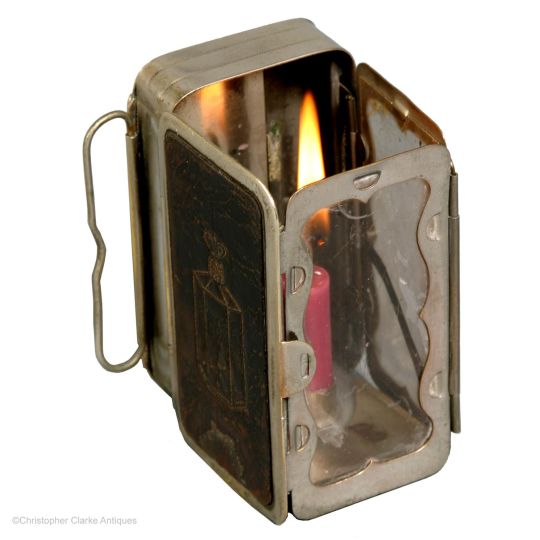
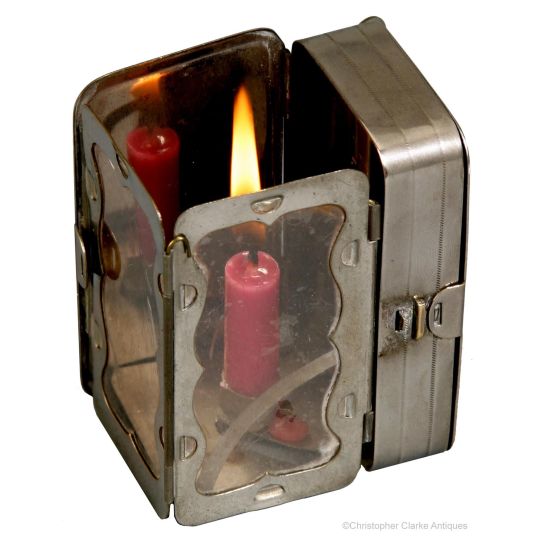
The clear part was mica - a transparent mineral which can be split into thin flexible sheets - while others use horn / parchment, though both of these are translucent rather than transparent. Regardless, all were far less likely to break than glass.
One or two inner surfaces were usually tin, giving the lantern its own built-in reflector, and tech-level-wise, tin as a shiny or decorative finish has been used since Roman times.
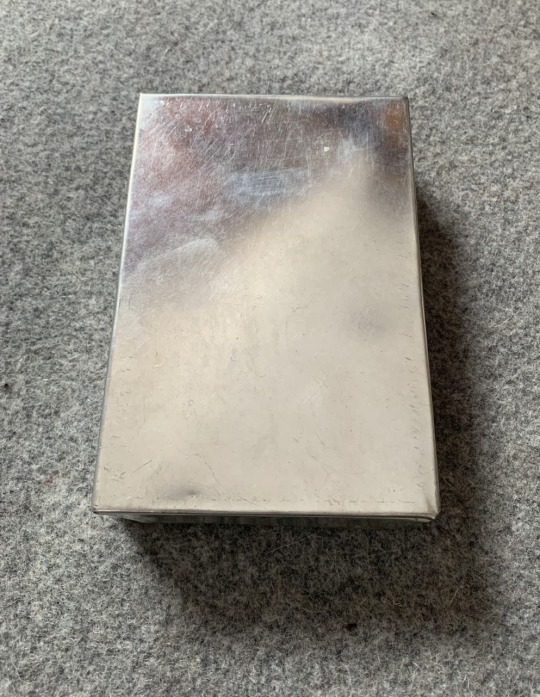
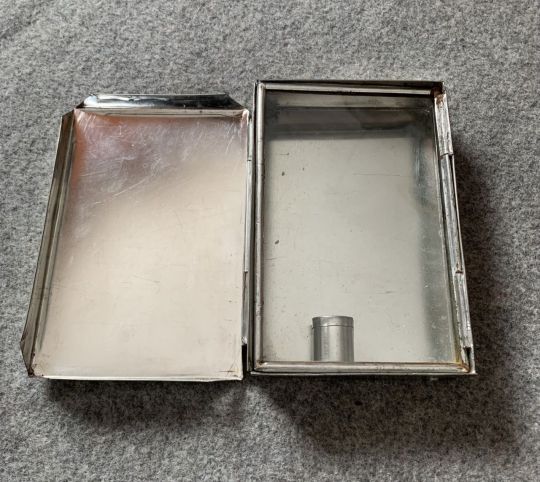

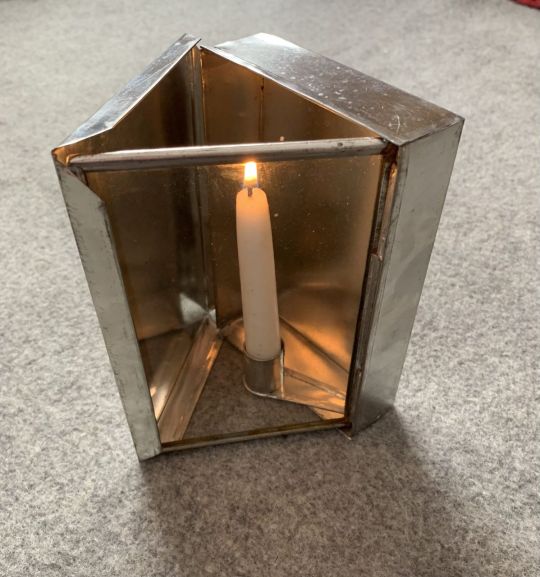
I'm pretty sure that top-of-the-line models could also have been finished with their own matching, maybe even built-in, tinderboxes.
And if real ones didn't, fictional ones certainly could. :->
*****
Yet more period lighting stuff here, including flintlock alarm clocks (!)
#period lighting#tinderbox#too light too dark#social history#writer notes#research#period tech#sword vs lantern#c. j. cherryh
2K notes
·
View notes
Text
A while ago, I got to join a kind of stream held by the script coordinator of HZ (Kureha Matsuzawa) after the broadcast of an episode he wrote.
He shared a few tidbits of his work and was really enthusiastic about Horizons and Pkmn in general. It was nice to witness so much passion behind the writing.
#he also got to read my comment and thank me personally for my words because he thought they were encouraging#which made me really happy w#since i really enjoy his eps and write a lot about them.#i think he was happy that i paid attention to the scriptwriters and remembered who writes what (more or less)#man i wrote so many words about the amlk cave ep or the og explorers story.. worry not.. i most definitely pay attention to these things-#i also remember his answer about one bit of my message being quite funny because of the way he said it (it was about spinel)#(i didn't get the whole thing. but i want to remember that it was funny to me at that time w)#it was nice. just a lot of passion and enthusiasm for stories there#this scriptwriter really enjoys writing (writing as a full art form) and it's cool seeing these kinds of stories unravel#makes me really look forward to his next eps and what there is in store next..#writer notes
15 notes
·
View notes
Text
ELAIN ARCHERON IS A MIDDLE CHILD
#elain archeron#archeron sisters#acotar#acomaf#acowar#acofas#acosf#sarah j maas#maasverse#high fae#seer#spring court#night court#autumn court#ezriel#elucien#middle child#writer notes#reread#fanon#canon#a court of questions#Gwynlain
27 notes
·
View notes
Text
I’m still trying to figure out what type of activity would lead to Class 1A into playing chicken, and like Bakugo is on Deku’s shoulders. Like Deku giving the comment “shut up you delicate flower. I lifted pillows heavier than you.”
I just want smack down sass. Like full on princess treatment Kacchan with Deku vomits out backhanded compliments that makes Kacchan blush like a mad man
Just something trash talking each other is so romantic. But Deku and Kacchan would nerd it up while trying to one up each other. It’s super cute.
14 notes
·
View notes
Text
Thank you
I took this screenshot earlier today, but I realized today my AO3 account hit 4K hits.

It’s been a little over a year since I first started writing fanfiction again, after an 8 year break from writing in general, so to have this much traction is still unbelievable.
I know I sometimes Iament about not having consistent engagement, (and doubting myself in general) however I’m still grateful for everyone that gave my writing a chance.
I’m still chuffing away at art and writing when I can, but I still wanted to take a moment and say
Thank you!

Also thank you for those following on tumblr (mutuals and esteemed guests) I know 21 is a humble number, but it still means a lot.
6 notes
·
View notes
Text
starting a collection of my favourite AO3 author’s notes





honourable mentions


#please reblog with your favourites too!#I wanna read them#ao3#fanfiction#ao3 author#fic writing#fanfic#ao3 fanfic#ao3 writer#ao3 authors notes#memes#tumblr memes#funny memes#humor#funny#haha#lol#ao3 memes#archive of our own#minyicho#jokes#funny jokes#funny post#funny stuff
29K notes
·
View notes
Note
Recent article on NPR about the history of artificial light somewhat frustrated me -- they portrayed all of pre-kerosene history as dark and heinously expensive at all times. Thing is, the writers based their findings solely on tallow candles, & ignored oil lamps, beeswax candles, clever use of refraction & outdoor light including moon/starlight... Also seemed to ignore the ubiquity of hearths / cook fires. Was wondering if you'd be willing to talk about non-tallow light? This isn't to ignore that truly, artificial lighting WAS much more difficult & expensive for much of human history, but acting like tallow candles were the ONLY light source seems very silly! (Plus your other lovely post about bottles of water used to make those candles more efficient via refraction & focus)
I'm betting the article you mean is this one - which refers back to this one.
For matching reference, my own posts about period lighting are here, One and Two, including observations about painting walls white, how to light candles and lamps without matches, and several other matters.
*****
It didn't take too much listening before I got tetchy, because the first half of this podcast seems more about mocking how WEIRD and PRIMITIVE old-time people were, than passing on any useful information.
Despite the presence of Jane Brox (author of "Brilliant: The Evolution of Artificial Light") whale oil only gets touched on in passing, and olive oil isn't mentioned at all.
Instead she starts talking about using oily seabirds (stormy petrels) as "candles", despite this scholarly study concluding that it was something talked about far more than done, besides being so very, very localised that its relevance to the history of lighting is very, very small.
But hey, WEIRD and PRIMITIVE, right?
*****
By contrast, making candles was so commonplace that it was another of those jobs which created surnames. Fletcher once put feathers on arrows, Cooper made barrels, Fisher, Miller, Baker and Farmer are obvious, and Chandler used to make candles.
Lampier, of course, made lamps, which helped keep those naked candle-flames away from anywhere they shouldn't touch. The man on the left is making the lantern bodies, the one on the right is shaving sheets of horn as windows.

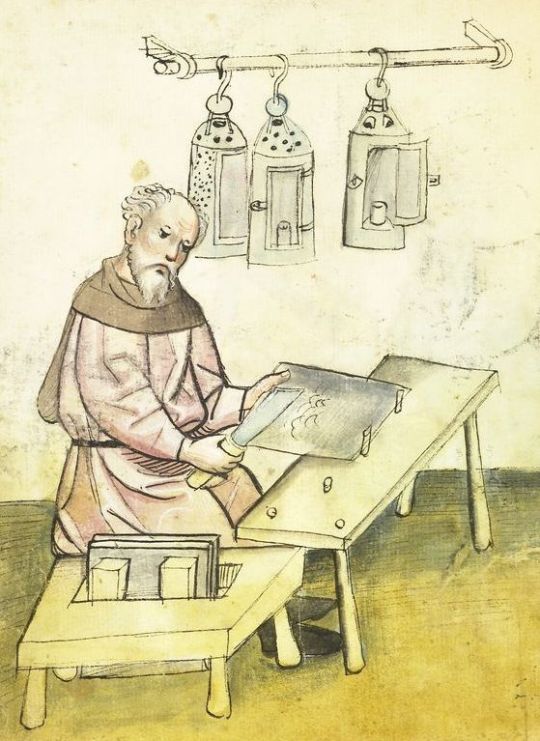
It's cheaper than glass, less easily broken yet is translucent enough, when shaved properly thin, to give quite adequate light.

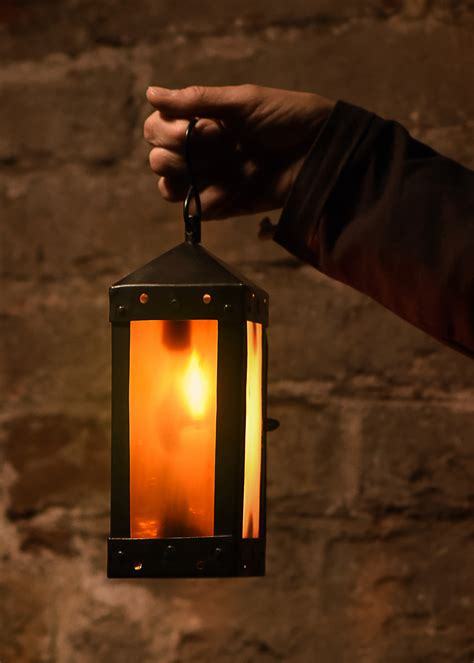
*****
The podcast has a digression about measuring the light output of a reproduction Ancient Babylonian lamp. Here's an original and a repro.


Yet that too says nothing about what fuel the lamp is or should be burning - olive oil, traded all over the Mediterranean by ancient olive-growing cultures.
These are Roman oil-lamps, from simple and cheap to elaborate and costly.


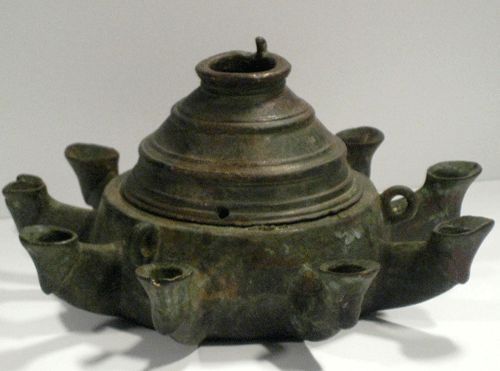

As for beeswax, so far as the podcast is concerned might as well not exist, despite being a by-product of honey, which was THE principal pre-sugar sweetener for centuries when not being made into all that mead whose existence, production and quaffing nobody questions.
Oh yeah, and then there was the amazed discovery (2:40 / 1:25, depending on which you're listening to) that melted beef fat "...smells really nasty, like, ANIMAL nasty,"
Why is this guy surprised? It's part of an animal!
*****
It's the same sort of infotainment ignorance as displayed by this TikTok twit, right up to complaining about the effort involved in preparation of anything because not having powered appliances was so labour-intensive, oh woe. Yes, it was, welcome to any historical period before about 1920. That's where "the daily grind" originates.
However the implication (listen, it's there) that cattle were raised just to provide fat for candles is ludicrous. The fat was a by-product, not a main one, and was often a butcher's side-line, while members of the Chandlers' Guild only worked with superior beeswax.
I don't think you could make candles like these with tallow:


...and you definitely couldn't make one meant to be hand-held.

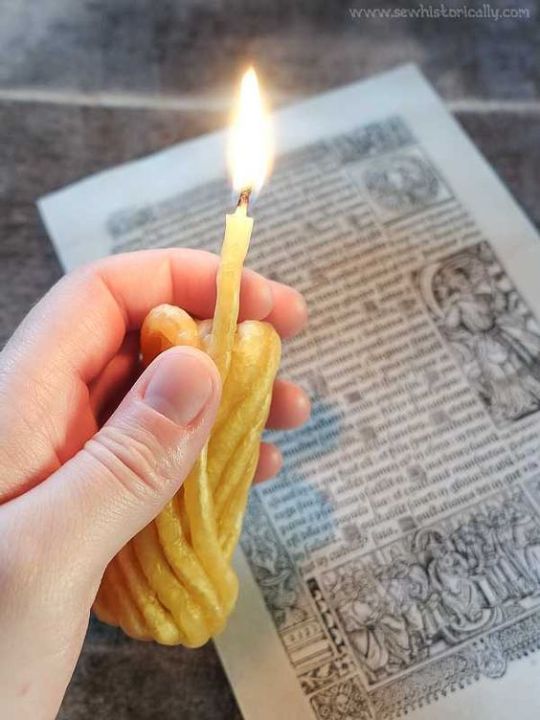
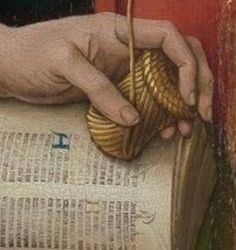
Picture evidence shows, by their clothing, the class of society who bought these, and tallow-greasy fingers would have been a no-no.

A Chandler didn't make individual candles. By the time that fresh batch is hung up, the first batch away down at the end is cool enough to be dipped again.

A chandler's shop in a medieval city would look very similar, and often had a horizontal wheel on which to hang each batch of candles, rotating them up and around to cool, then back to the dipping pot. Non-modern people may not have had modern tech or time-and-motion studies, but they weren't stupid.
*****
By contrast, the podcast's disparaging attitude of WEIRD and PRIMITIVE is emphasised by what seems a deliberate avoidance of anything which counters it (examples of that in my own posts) and finally at 11.24 / 9:50 came this:
"Even when you get all the way to the 1700s (...) most people are still subsistence farmers, living in some kind of hut, trying to grow enough food not to starve to death (...) and light? Light still comes from finding stuff that's lying around and just lighting it on fire."
Some kind of hut...
Stuff that's lying around...
After making such a declaration, I'm surprised - since they'd been implying it for half the podcast - someone didn't just go ahead and announce that "there's some lovely filth down here..."

That's when I stopped listening.
Enough is enough, and I'd had it.
*****
ETA:
cc: @asmuchasidliketo :->
Here's a photo of what purports to be a Petrel (not petrol, that's something else) Candle, held in the Pitt-Rivers Museum, Oxford. It's mentioned in that scholarly article I linked above.

Just as "one swallow doesn't make a summer", so one - and only one - known example of this, which may have been a fake-up to spoof the Southerners, doesn't prove it was a common or even rare practice.
There's another reason to take this with a big pinch of salt, so maybe Jane Brox was on a low-sodium diet when she wrote her book.
Creatures with a layer of fat or blubber for insulation all have it like any other form of insulation, on the outside, where it does some good. A wick passed through the inside couldn't draw on it for fuel since there's a layer of muscle and another of internal organs for the oil to get through first.
The cropped-off bottle just visible to the left is a far more likely way seabirds became lamp fuel: by rendering out their oil. This oil is from the Northern Fulmar, Fulmaris glaciaris (or glacialis, I've seen both. Same bird regardless).
Incidentally, the Wikipedia article on European Storm Petrel mentions a supernatural connection, that the petrels were the souls of drowned sailors, and killing them is unlucky.
Not just killing them but making them into candles sounds like A Bad Idea, and is yet another reason why, IMO, the candle thing may be a folktale, or a deliberate leg-pull, or...
Let's just say "improbable" and leave it there. :-P
462 notes
·
View notes
Text

sinners: how real stories of irish and choctaw oppression inform the film
#sinners#sinners 2025#please read this article its so good#also the little note about remmick choosing to sing rocky road to dublin over any other song......... Wuff#edit: didn't expect this to get as many notes as it did so for the record i dont agree with everything the writer talks about#but i thought their analysis was worth sharing anyways
15K notes
·
View notes
Text

Can’t help stop thinking about why Masaru’s quirk, and the fact he could have gone the hero route. I’m attempting to drive into to my own head canon on the many reasons he chose design instead.
Like what other reasons did he decide design of all things, besides being a passion. What happened in his past that deterred him from going the hero route?
Based on how we’re introduced to how villains and heroes can destroy their surroundings. Like, all the destruction that comes with that line of work. It’s very similar how war effects daily lives of civilians. Some of us go numb to it when it doesn’t affect us. But those who are affected it’s like questioning if you’ll live to see tomorrow.
I recently drafted a chapter where I tried to address one of the reasons Masaru probably chose the “quiet” life. War is painful. Especially when you’re constantly surrounded by it.
Even people who’s line of work is putting their life in danger everyday is painful for the people they love. Never knowing if the next fire will be your last. Never knowing if you’ll be shot when dealing with a criminal. Never knowing if you’ll reach the hospital or you’ll be the one who needs an ambulance.
Then to add people who has abilities that can cause natural disasters any time. A constant struggle to survive and make it to the next day. Even why you don’t think you’ll be affected until it happens to you.
#bakugo katsuki#fanfic#mha#bakugo masaru#writer thoughts#writer notes#war#deep thoughts#fanfic notes#obsessive thoughts#random observations#observation thoughts
16 notes
·
View notes
Text
“return to old trek,” but it’s the return of 20+ episode seasons, of bringing contemporary scifi writers to write episodes, of doing social commentary so acute it blasts the “it’s just escapism” argument to bloody bits, and most important, the return of silly costumes and camp
#note: the first three things on the list are what i actually want the fourth one is more of a byeffect of general sincerity#star trek#star trek tos#my personal picks for episode writers would be martha wells and nnedi okorafor
8K notes
·
View notes
Text
no matter how fucking sad I am, any AO3 email never fails to makes my day a little brighter
#rambling#writing fanfiction#writing#fanfiction#ao3#writers on tumblr#so idk what happened#just a disclaimer i do understand that not every email is gonna be positive#i was talking about a very specific personal situation#idk why this blew up#why is this 4k notes i only left for a few days
9K notes
·
View notes
Text
Too late.
Far too late...
(Getting advice is one thing. Heeding advice is quite another.)
*through sweat, blood, and tears* YOU WILL NOT EDIT THE FIRST DRAFT AS YOU GO. YOU WILL NOT EDIT THE FIRST DRAFT AS YOU GO. YOU WILL NOT EDIT THE FIRST DRAFT. AS YOU GO.
YOU. WILL. NOT. EDIT. THAT. FIRST. DRAFT.
6K notes
·
View notes
Text
Writing Notes & References
Alchemy ⚜ Antidote to Anxiety ⚜ Attachment ⚜ Autopsy
Art: Elements ⚜ Principles ⚜ Photographs ⚜ Watercolour
Bruises ⚜ Caffeine ⚜ Color Blindness ⚜ Cruise Ships
Children ⚜ Children's Dialogue ⚜ Childhood Bilingualism
Dangerousness ⚜ Drowning ⚜ Dystopia ⚜ Dystopian World
Culture ⚜ Culture Shock ⚜ Ethnocentrism & Cultural Relativism
Emotions: Anger ⚜ Fear ⚜ Happiness ⚜ Sadness
Emotional Intelligence ⚜ Genius (Giftedness) ⚜ Quirks
Facial Expressions ⚜ Laughter & Humour ⚜ Swearing & Taboo
Fantasy Creatures ⚜ Fantasy World Building
Generations ⚜ Literary & Character Tropes
Fight Scenes ⚜ Kill Adverbs
Food: Cooking Basics ⚜ Herbs & Spices ⚜ Sauces ⚜ Wine-tasting ⚜ Aphrodisiacs ⚜ List of Aphrodisiacs ⚜ Food History ⚜ Cocktails ⚜ Literary & Hollywood Cocktails ⚜ Liqueurs
Genre: Crime ⚜ Horror ⚜ Fantasy ⚜ Speculative Biology
Hate ⚜ Love ⚜ Kinds of Love ⚜ The Physiology of Love
How to Write: Food ⚜ Colours ⚜ Drunkenness
Jargon ⚜ Logical Fallacies ⚜ Memory ⚜ Memoir
Magic: Magic System ⚜ 10 Uncommon ⚜ How to Choose
Moon: Part 1 2 ⚜ Related Words
Mystical Items & Objects ⚜ Talisman ⚜ Relics ⚜ Poison
Pain ⚜ Pain & Violence ⚜ Poison Ivy & Poison Oak
Realistic Injuries ⚜ Rejection ⚜ Structural Issues ⚜ Villains
Symbolism: Colors ⚜ Food ⚜ Numbers ⚜ Storms
Thinking ⚜ Thinking Styles ⚜ Thought Distortions
Terms of Endearment ⚜ Ways of Saying "No" ⚜ Yoga
Compilations: Plot ⚜ Character ⚜ Worldbuilding ⚜ For Poets ⚜ Tips & Advice
all posts are queued. will update this every few weeks/months. send questions or requests here ⚜ Writing Resources PDFs
#writing reference#writing inspiration#writeblr#dark academia#spilled ink#literature#writers on tumblr#poets on tumblr#light academia#lit#poetry#writing notes#fiction#novel#booklr#creative writing#writing prompts#writing ideas#worldbuilding#character design#plot#writing resources
16K notes
·
View notes
Text
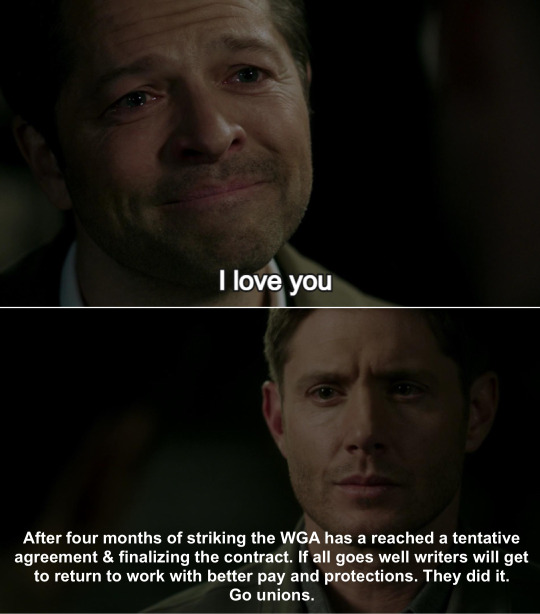
I’m so happy for them
[Image Description: Castiel from Supernatural is saying I love you, underneath is an image of Dean Winchester with the caption: “After four months of striking the WGA has a reached a tentative agreement & finalizing the contract. If all goes well writers will get to return to work with better pay and protections. They did it. Go unions”]
(Source)
#wga solidarity#wga strong#after months of watching union busting and anti union tactics#wga is coming out strong#hopefully sag is next!#writers strike#support unions#wga strike#sag strike#supernatural meme#destiel#destiel meme#workers rights#fuck the amptp#destiel news#mine#we’ve hit the note amount where people start fighting in the notes#stop fighting kids#but also the strike was absolutely necessary#withholding labor is how unions negotiate for better rights#the CEOs are multimillionaires who refused to pay proper wages#they needed to receive heavy losses so they’d actually come to the table listen to union demands
74K notes
·
View notes
Text
what is with this new wave of short drabbles with porn and zero plot what happened to yearning?? what happened to build up?? what happened to the character being absolutely down bad for reader?? what happened to the 10k words fics?? screaming crying and throwing up i miss it
#bethsvrse#I WRITE DRABBLES#I ENJOY READING DRABBLES#what i don’t like is when drabbles are pushed forward because so many readers now want quantity over quality#drabbles are pushed to the top despite so many writers putting their soul into longer fanfics#it’s disappointing especially being someone who has experienced my longer fanfics getting less than 100 notes#but my short drabbles getting over 1000 notes#fanfic#remus lupin x reader#peter parker x reader#steve harrington x reader#george weasley x reader#sirius black x reader#stiles stilinski x reader#spencer reid x reader#james potter x reader#bucky barnes x reader#robin buckley x reader#logan howlett x reader#andrew garfield x reader#neville longbottom x reader#x reader#wanda maximoff x reader#aaron hotchner x reader#dean winchester x reader#harry potter x reader
6K notes
·
View notes
Text
I'm surprised to see a How-To like this dated to the 1950s, when I'd have thought rotary dials weren't exactly new tech, but @dduane suggested It might have been because small US communities still relied on party lines and switchboards, where a number, PEnnsylvania 6-5000 for instance...
youtube
...was asked for rather than dialled personally, and actually using a dial phone might be an unfamiliar experience.
Oddly enough, this How-To doesn't actually explain how to USE the dial (on another page, probably) so here's how.
UK dial left, US dial right, operating principal the same.


Lift the earpiece or handset, put a fingertip into the appropriate numbered hole on the dial, drag it around to the finger-stop...
(ETA: the dragging went clockwise. The stop is curved on the "correct" side to meet the finger, and straight on the "wrong" one.)
...then remove the finger and let the dial rotate back to start position.
Don't force it, auto-rotation is what sends the number as a series of electrical pulses, so forcing it confuses things. (Voice of long-ago experience.)
Repeat for the remaining numbers, then speak when the call is answered. End the call by putting the earpiece / handset back in place.
*****
Aspects of outdated but still-in-memory social history fascinate me, partly because they were part of my life though now they seem to be museum exhibits, and also because various details are useful bits of info for fictional world-building.
For instance, in a small town or village it was common knowledge that the switchboard operator - not a government tapper, just a person you or your family might meet every day - could be listening to any phonecall, so sensitive subjects were avoided or worded with care.
Read on.
*****
I grew up with rotaries and the first I ever used - standing tiptoes on a chair - was one just like this wall-mounted contraption, which had been in my Grandad's grocery shop since about 1930, when his phone line was first connected.


Grandad was an earlier adopter. I've got a shop receipt stamp showing the phone number back then, which had only three digits. Numbers in the same town are now eight digits...
The "candlestick" phone (far more common in historical movies and TV dramas) had most of the same working telephone parts, but needed a table or desk to rest on and its connection box with bells mounted on a wall, whereas the wall-mount has this box built-in behind the dial and mouthpiece.
Also, since typical style of use involved two hands...



...if only to brace it on the table (they were top-heavy and could overbalance)...



...it was a lot less convenient for making notes or taking down orders.
NB an interesting little detail in that first photo - a sandglass egg-timer attached to the phone for timing calls.
*****
Writer Side-Note 1: the hooks for the earpiece have a spring. Take the earpiece off and it snaps up to make the connection, put the earpiece back and it drops down under the weight, breaking the connection.
I sometimes wonder (and should probably find out) if early phonership being higher in the US than across the Pond influenced why US light switches work the same way as the phone hook, up for on, down for off. UK / Irish ones are the opposite.
Certainly those hooks are why "pick up" means answering a call and "hang up" means ending it, even if nowadays both are done by tapping an on-screen icon.
Indeed, we still "dial" a number even though actual dials are long gone - unless they've been put back as an app, see below... :->
"Ringing off the hook" suggests a phone so busy that bits of it are jumping off - but also, that it's so busy it won't shut up even when disconnected.
In fact it would shut up if that happened, and gave rise to another phrase which nowadays has a slightly different origin and meaning.
Lifting the earpiece off its hook and putting it to one side without making a call meant anyone phoning the number would get a busy signal. Thus "off the hook" meant "can't be contacted", often with an implication of "doesn't want to be contacted."
Nowadays the phrase owes more to fishing than phones, so "off the hook" means "avoided a threat / got away" - though perhaps there's still a telephonic echo in "isn't caught". YMMV.
*****
Writer Side-Note 2: older phones didn't have a dial. Instead, lifting the earpiece made a connection (indicated AFAIK by a light) at the local "switchboard exchange", indicating that someone wanted to make a call.
The "telephonist" (usual term for working with an office network) or "operator" (usual term for working with a public network) would reply, find out which person (office) or number (public) the caller wanted to reach, and make the connection by hand.

The usual conversation went something like this:
"Hello, caller, which number do you require?"
"Mr Brandybuck's office, please," or "HOBbiton 3-5-7-9, please," or "Bywater police station, quickly!"
"Thank you, caller. One moment, please. Connecting you now... You're through."
The operator could also listen in to any conversation and, at small local exchanges where they weren't too busy and knew one or maybe both callers, they often did.
In fact and fiction this habit made them a useful source of gossip, information and evidence, and callers' awareness of it also meant that any "interesting" phonecall would be framed in guarded or oblique language which might sound a lot more suspicious than it really was.
*****
Whenever a caller in "Downton Abbey", "Peaky Blinders" or whatever rattles the hook of a phone up and down, it's because they're trying to get the operator's attention that bit faster by making the switchboard signal light blink.
Anyone who's pressed the call button on a lift several times to make it hurry up, even when that button's lit to show it's on the way, will know exactly what I mean. However, an old-style phone linked to an old-style switchboard might actually have had an effect. With lifts, not so much.
*****
Rotary phones got a lot sleeker as time went by...


...though they still had spring-loaded switches - those two little black nubbins - to open and close a connection. These too could be jiggled to "speed things up", though by this stage the exchange was usually automated so it was no more effective than prodding lift buttons.
Despite that, "picking up" and "hanging up" remained a fairly accurate description, especially with wall-mounted phones.

This style of phone, or at least their hand-set design, still provides the basis for phone icons in many / most smartphones.


*****
Rotary phones went out of style in favour of push-button designs, including cordless ones...



This carried over to mobile phones, first big...

...then not so big...

...then small, then smart and getting big again...

Smartphones also started with push-buttons before going over to touch-screens, and now what goes around comes around, with apps for those touchscreens to simulate both push-button and rotary phones.

To complete the retro experience there are (or were, anyway) vintage-phone charging docks with working handsets.
Install a rotary-dialler app in this, and it's back to the future.

Especially if there are cradle switches to jiggle so the cell connects faster...
:->

“How to Use a Dial Telephone” 1951.
#rotary phone#old tech#retro tech#social history#vintage telephone use#writer notes#research#history for fun#Youtube
2K notes
·
View notes